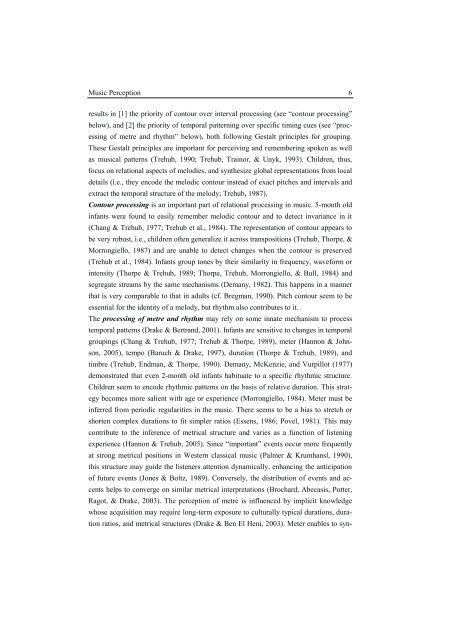Neural Correlates of Processing Syntax in Music and ... - PubMan
Neural Correlates of Processing Syntax in Music and ... - PubMan
Neural Correlates of Processing Syntax in Music and ... - PubMan
You also want an ePaper? Increase the reach of your titles
YUMPU automatically turns print PDFs into web optimized ePapers that Google loves.
<strong>Music</strong> Perception 6<br />
results <strong>in</strong> [1] the priority <strong>of</strong> contour over <strong>in</strong>terval process<strong>in</strong>g (see “contour process<strong>in</strong>g”<br />
below), <strong>and</strong> [2] the priority <strong>of</strong> temporal pattern<strong>in</strong>g over specific tim<strong>in</strong>g cues (see “process<strong>in</strong>g<br />
<strong>of</strong> metre <strong>and</strong> rhythm” below), both follow<strong>in</strong>g Gestalt pr<strong>in</strong>ciples for group<strong>in</strong>g.<br />
These Gestalt pr<strong>in</strong>ciples are important for perceiv<strong>in</strong>g <strong>and</strong> remember<strong>in</strong>g spoken as well<br />
as musical patterns (Trehub, 1990; Trehub, Tra<strong>in</strong>or, & Unyk, 1993). Children, thus,<br />
focus on relational aspects <strong>of</strong> melodies, <strong>and</strong> synthesize global representations from local<br />
details (i.e., they encode the melodic contour <strong>in</strong>stead <strong>of</strong> exact pitches <strong>and</strong> <strong>in</strong>tervals <strong>and</strong><br />
extract the temporal structure <strong>of</strong> the melody; Trehub, 1987).<br />
Contour process<strong>in</strong>g is an important part <strong>of</strong> relational process<strong>in</strong>g <strong>in</strong> music. 5-month old<br />
<strong>in</strong>fants were found to easily remember melodic contour <strong>and</strong> to detect <strong>in</strong>variance <strong>in</strong> it<br />
(Chang & Trehub, 1977; Trehub et al., 1984). The representation <strong>of</strong> contour appears to<br />
be very robust, i.e., children <strong>of</strong>ten generalize it across transpositions (Trehub, Thorpe, &<br />
Morrongiello, 1987) <strong>and</strong> are unable to detect changes when the contour is preserved<br />
(Trehub et al., 1984). Infants group tones by their similarity <strong>in</strong> frequency, waveform or<br />
<strong>in</strong>tensity (Thorpe & Trehub, 1989; Thorpe, Trehub, Morrongiello, & Bull, 1984) <strong>and</strong><br />
segregate streams by the same mechanisms (Demany, 1982). This happens <strong>in</strong> a manner<br />
that is very comparable to that <strong>in</strong> adults (cf. Bregman, 1990). Pitch contour seem to be<br />
essential for the identity <strong>of</strong> a melody, but rhythm also contributes to it.<br />
The process<strong>in</strong>g <strong>of</strong> metre <strong>and</strong> rhythm may rely on some <strong>in</strong>nate mechanism to process<br />
temporal patterns (Drake & Bertr<strong>and</strong>, 2001). Infants are sensitive to changes <strong>in</strong> temporal<br />
group<strong>in</strong>gs (Chang & Trehub, 1977; Trehub & Thorpe, 1989), meter (Hannon & Johnson,<br />
2005), tempo (Baruch & Drake, 1997), duration (Thorpe & Trehub, 1989), <strong>and</strong><br />
timbre (Trehub, Endman, & Thorpe, 1990). Demany, McKenzie, <strong>and</strong> Vurpillot (1977)<br />
demonstrated that even 2-month old <strong>in</strong>fants habituate to a specific rhythmic structure.<br />
Children seem to encode rhythmic patterns on the basis <strong>of</strong> relative duration. This strategy<br />
becomes more salient with age or experience (Morrongiello, 1984). Meter must be<br />
<strong>in</strong>ferred from periodic regularities <strong>in</strong> the music. There seems to be a bias to stretch or<br />
shorten complex durations to fit simpler ratios (Essens, 1986; Povel, 1981). This may<br />
contribute to the <strong>in</strong>ference <strong>of</strong> metrical structure <strong>and</strong> varies as a function <strong>of</strong> listen<strong>in</strong>g<br />
experience (Hannon & Trehub, 2005). S<strong>in</strong>ce “important” events occur more frequently<br />
at strong metrical positions <strong>in</strong> Western classical music (Palmer & Krumhansl, 1990),<br />
this structure may guide the listeners attention dynamically, enhanc<strong>in</strong>g the anticipation<br />
<strong>of</strong> future events (Jones & Boltz, 1989). Conversely, the distribution <strong>of</strong> events <strong>and</strong> accents<br />
helps to converge on similar metrical <strong>in</strong>terpretations (Brochard, Abecasis, Potter,<br />
Ragot, & Drake, 2003). The perception <strong>of</strong> metre is <strong>in</strong>fluenced by implicit knowledge<br />
whose acquisition may require long-term exposure to culturally typical durations, duration<br />
ratios, <strong>and</strong> metrical structures (Drake & Ben El Heni, 2003). Meter enables to syn-












